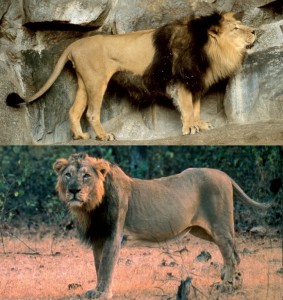There are plenty of animals in zoos and private collections which the proprietors claim to be ‘barbary lions’. In the early 1970s during work at Rabat Zoo, Leyhausen and Hemmer set out a list of characteristics to sift out animals with possibly Barbary lion ancestry using the following criteria:

A captive male Indian lion (P.l. persica) grows a luxuriant dark mane in Berlin zoo (top), whilst his wild counterpart has a much more modest offer (photos N Yamaguchi)
1. longer, shaggy fur
2. huge mane (head to belly)
3. mane darker to the rear
4. a greyish colour to coat
6. well-developed tail tuft
5. long hair (♀ & juvenile ♂)
(neck/throat/front legs/belly)
7. high crown (so a straight line from nose to top of head)
8. rounded cheek and narrow muzzle
9. concave profile to front of skull
10.prominent anterior edge of the pelvis
11. pale yolk yellow iris (not dark yellow or olive)
12. narrow post-orbital constriction of skull
Many observers distill this list down to the first three items – the shaggy fur, mane size and mane colour.
Unfortunately these three characteristics are affected by climatic considerations. If you put a lion in a colder climate it grows a shaggier mane. This means that shaggy lions in zoos in Europe and North America are no more likely to be of Barbary ancestory than anywhere else.
Further Reading:
Patterson, B.D., Kays, R.W., Kasiki, S.M. and Sebestyen, V.M. (2006) Developmental effects of climate on the lion’s mane (Panther leo). Journal of Mammology, 82(2): 193-200
Yamaguchi, Nobuyuki; Cooper, Alan; Werdelin, Lars; MacDonald, David W. (2004). “Evolution of the mane and group-living in the lion (Panthera leo): a review”. Journal of Zoology 263 (4): 329.
